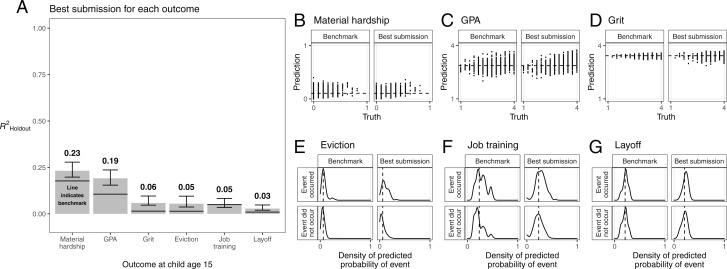SOCIAL SCIENCES Correction for “Measuring the predictability of life outcomes with a scientific mass collaboration,” by Matthew J. Salganik, Ian Lundberg, Alexander T. Kindel, Caitlin E. Ahearn, Khaled Al-Ghoneim, Abdullah Almaatouq, Drew M. Altschul, Jennie E. Brand, Nicole Bohme Carnegie, Ryan James Compton, Debanjan Datta, Thomas Davidson, Anna Filippova, Connor Gilroy, Brian J. Goode, Eaman Jahani, Ridhi Kashyap, Antje Kirchner, Stephen McKay, Allison C. Morgan, Alex Pentland, Kivan Polimis, Louis Raes, Daniel E. Rigobon, Claudia V. Roberts, Diana M. Stanescu, Yoshihiko Suhara, Adaner Usmani, Erik H. Wang, Muna Adem, Abdulla Alhajri, Bedoor AlShebli, Redwane Amin, Ryan B. Amos, Lisa P. Argyle, Livia Baer-Bositis, Moritz Büchi, Bo-Ryehn Chung, William Eggert, Gregory Faletto, Zhilin Fan, Jeremy Freese, Tejomay Gadgil, Josh Gagné, Yue Gao, Andrew Halpern-Manners, Sonia P. Hashim, Sonia Hausen, Guanhua He, Kimberly Higuera, Bernie Hogan, Ilana M. Horwitz, Lisa M. Hummel, Naman Jain, Kun Jin, David Jurgens, Patrick Kaminski, Areg Karapetyan, E. H. Kim, Ben Leizman, Naijia Liu, Malte Möser, Andrew E. Mack, Mayank Mahajan, Noah Mandell, Helge Marahrens, Diana Mercado-Garcia, Viola Mocz, Katariina Mueller-Gastell, Ahmed Musse, Qiankun Niu, William Nowak, Hamidreza Omidvar, Andrew Or, Karen Ouyang, Katy M. Pinto, Ethan Porter, Kristin E. Porter, Crystal Qian, Tamkinat Rauf, Anahit Sargsyan, Thomas Schaffner, Landon Schnabel, Bryan Schonfeld, Ben Sender, Jonathan D. Tang, Emma Tsurkov, Austin van Loon, Onur Varol, Xiafei Wang, Zhi Wang, Julia Wang, Flora Wang, Samantha Weissman, Kirstie Whitaker, Maria K. Wolters, Wei Lee Woon, James Wu, Catherine Wu, Kengran Yang, Jingwen Yin, Bingyu Zhao, Chenyun Zhu, Jeanne Brooks-Gunn, Barbara E. Engelhardt, Moritz Hardt, Dean Knox, Karen Levy, Arvind Narayanan, Brandon M. Stewart, Duncan J. Watts, and Sara McLanahan, which was first published March 30, 2020; 10.1073/pnas.1915006117 (Proc. Natl. Acad. Sci. U.S.A. 117, 8398–8403).
The authors note that: “A coding error affected some of the results in Fig. 3 and SI Appendix, Figs. S6, S7, S8, and S9. Our paper stated that the benchmark model used linear regression for predicting continuous outcomes and logistic regression for binary outcomes. However, the code for the benchmark model used linear regression for all outcomes. We are grateful to Charles Rahal and Mark Verhagen for calling this issue to our attention. Additionally, while investigating this issue we discovered that a data file used to produce Figs. S17 and S18 was out of date and some of the R package versions listed in the SI Appendix were incorrect. None of these issues impact our conclusions.”
Fig. 3.
Performance in the holdout data of the best submissions and a four variable benchmark model (SI Appendix, section S2.2). A shows the best performance (bars) and a benchmark model (lines). Error bars are 95% confidence intervals (SI Appendix, section S2.1). B–D compare the predictions and the truth; perfect predictions would lie along the diagonal. E–G show the predicted probabilities for cases where the event happened and where the event did not happen. In B–G, the dashed line is the mean of the training data for that outcome.
The corrected Fig. 3 and legend appears below. The online version has been corrected.
In the SI Appendix, on page S15, third full paragraph, lines 8–9, “The best submission for layoff, for instance, achieved R2Holdout four times that achieved by the benchmark” should instead appear as “The best submission for layoff, for instance, achieved R2Holdout three times that achieved by the benchmark.”
On page S18, third full paragraph, lines 2–3, “Between 31% (layoff) and 100% (job training)” should instead appear as “Between 31% (layoff) and 95% (job training).”
The SI Appendix has been updated to include this updated text, corrected Figs. S6, S7, S8, S9, S17, and S18, and corrected version numbers of the R packages.



